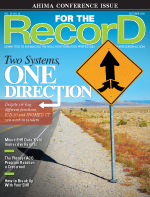October  2013
2013
Template-Dictation Combo A Winner
By Marilyn Trapani
For The Record
Vol. 25 No. 14 P. 7
In an era when the amount of health care information astounds, providers find themselves in a quandary: How do they ensure complete patient information is communicated to medical records, coding, and third-party payers? How do they integrate clinical documentation improvement and incorporate all of the changes needed for ICD-10 implementation while still giving clinicians the information they need for patient care?
Medical records directors and committees across the country are wrangling with this predicament while hoping to keep costs in check. While transcription departments still consume a large part of hospital budgets, they also can be the largest source of consistent reimbursement.
In an EMR environment, physicians can enter information into the system manually, dictate portions of documents, and copy historical information from one document to another. It can be complicated, making compliance more difficult.
The physician must manipulate historical records, attempt to dictate, and incorporate the transcribed section into the same document while using check boxes that may or may not be descriptive of a particular patient. Physicians intend to create a complete record, but sometimes their good intentions fall short, and the medical records department must wait patiently for them to complete the process.
An Old Standby
New technology is enthralling, but sometimes it comes at a cost. The complex nature of some cases generally is not reflected in an EMR’s check boxes. If physicians spend two to three hours per day coordinating partial dictation with historical sections of documents, patient care will suffer. Fewer patients will be seen, fewer procedures performed, and less revenue generated. There also are compliance concerns involving getting physicians to actually complete the tasks. It may result in hospitals paying clerical staff to chase down physicians to gather the information necessary to complete records.
One possible solution to maintaining timely, accurate data is utilizing full dictation and transcription with EMR modules identifying compliance problems. It remains the most efficient and time-saving system for physicians to complete medical records without changing their workflow. Dictation is simple, a process that can be accomplished at any time through multiple mobile applications as well as by telephone.
Framework for Success
Designed by medical records committees and approved by physician leaders, templates for report types can be created to meet ICD-10 requirements. Trained physicians dictate the necessary information, and a transcriptionist enters the data into a concise file format. If an organization opts for partial dictation, the report’s transcribed section can be uploaded via a Health Level Seven International format to the chosen EMR and melded to the check-box information that the physician selected to begin the process.
Because coding for maximum reimbursement is the goal of any financially responsible hospital, the final transcribed report is the lifeblood of success. Missing or incomplete information can delay reimbursement and require excessive queries by other practitioners to complete care and billing. The appropriate use of templates guides the practitioner to ensure that all components of care are documented.
ICD-10 requires the collection and documentation of greater amounts of data, creating more opportunity for errors. Because physician dictation generally is a narrative without regard to templates, a well-crafted template requires a transcriptionist’s input to ensure that details are documented under the correct sections of the report.
In a voice recognition environment, it is imperative to have a transcriptionist review and edit the document to make sure dictated information is placed within proper headings for each template design. Missing information is flagged for physicians to edit when they receive the transcribed document.
Maintaining consistency in all reports provides the coding team with a quick and easily formatted structure to provide billing with the necessary codes for proper reimbursement without waiting for physician-queried responses. As physicians get used to working with standardized document work types, their dictation begins to reflect the formatting of each document type under the template’s guidance.
Chart Reviews
More ambulatory centers and offices are implementing EMRs designed specifically for their environment. At the same time, recovery audit contractors and Medicare administrative contractors are conducting audits to examine whether health care organizations are properly documenting patient care. Improper documentation results in overpayments, stipends that must be repaid to the government.
Meanwhile, having a fully transcribed document complete with proper documentation has resulted in some organizations gaining reimbursement. By guiding patient visit documentation, templated information can assist in the recovery of proper reimbursement.
Keeping transcription work in the hands of US citizens can reduce language errors and incorrect information. American transcriptionists understand template-based workflows and revenue cycle processes, and they produce high-quality, grammatically correct transcription.
No matter who’s transcribing, the devil is in the details, which need to be rich with patient data to produce better care and appropriate reimbursement.
— Marilyn Trapani is president, founder, and CEO of Silent Type, a transcription and documentation management company.



